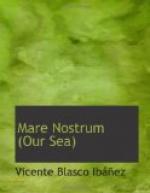Clouds the color of pit coal reflected the ship’s slow progress over the sea; showers of rain like whipcord occasionally lashed the deck, followed by a flaming sun that was soon blotted out by a new downpour. These clouds, pregnant with cataracts, this night descending upon the full daylight of the Atlantic, had been the terror of the ancients, and yet, thanks to just such phenomena, the sailors could pass from one hemisphere to another without the light wounding them to death, or the sea scorching them like a burning glass. The heat of the equator, raising up the water in steam, had formed a band of shade around the earth. From other worlds it must appear like a girdle of clouds almost similar to the sidereal rings.
In this gloomy, hot sea was the heart of the ocean, the center of the circulatory life of the planet. The sky was a regulator that, absorbing and returning, restored the evaporation to equilibrium. From this place were sent forth the rains and dews to all the rest of the earth, modifying its temperatures favorably for the development of animal and vegetable life. There were exchanged the exhalations of the two worlds; and, converted into clouds, the water of the southern hemisphere—the hemisphere of the great seas with no other points of relief than the triangular extremities of Africa and America, and the humps of the oceanic archipelagoes—was always reinforcing the rills and rivers of the northern hemisphere with its inhabited lands.
From this equatorial zone, the heart of the globe, come forth two rivers of tepid water that heat the coasts of the north. They are the two currents that issue from the Gulf of Mexico and the Java Sea. Their enormous liquid masses, fleeing ceaselessly from the equator, govern a vast assemblage of water from the poles that comes to occupy their space, and these chilled and fresher currents are constantly precipitating themselves on the electric hearth of the equator that warms and salts them anew, renewing with its systole and diastole the life of the world. The ocean struggles vainly to condense these two warm currents without ever succeeding in mingling itself with them. They are torrents of a deep blue, almost black, that flow across the cold and green waters.
The Atlantic current, upon reaching Newfoundland, divides its arms, sending one of them to the North Pole. With the other, weak and exhausted by its long journey, it modifies the temperature of the British Isles, tempering refreshingly the coasts of Norway. The Indian current that the Japanese call, because of its color, “the black river,” circulates between the islands, maintaining for a longer time than the other its prodigious powers of creation and agitation which enable it to trail over the planet an enormous tail of life.
Its center is the apogee of terrestrial energy in the vegetable and animal creations, in monsters and in fish. One of its arms, escaping toward the south, goes on forming the mysterious world of the coral sea. In a space as large as four continents, the polyps, strengthened by the lukewarm water, are building up thousands of atolls, ring-shaped islands, reefs and submarine pillars that, when united together by the work of a thousand years, are going to create a new land, an exchange continent in case the human species should lose its present base in some cataclysm of Nature.




